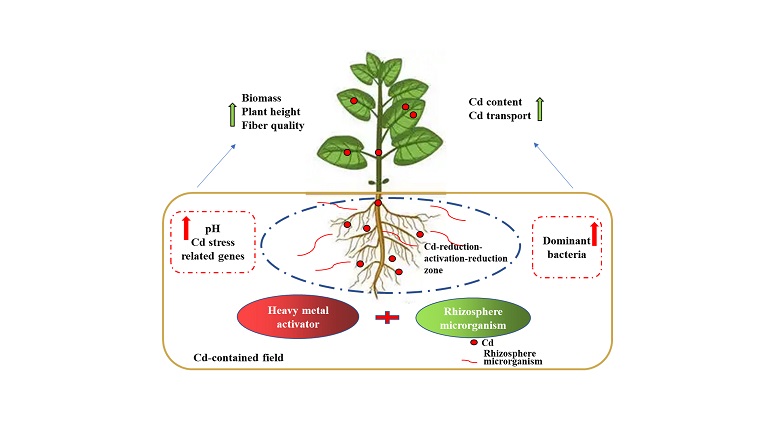
Researchers of the innovative team for genetic breeding of bast fiber crops from the Institute of Bast Fiber Crops, Chinese Academy of Agricultural Sciences, systematically studied the remediation of cadmium contaminated soil by ramie ( Boehmeria nivea L.) and revealed its microbial regulation mechanism, which provided technology roadmap and practice experience for research in the field of phytoremediation of heavy metal pollution.
Ramie is an ideal crop for remediation of cadmium contaminated soil. China has abundant ramie germplasms, but as ramie is a perennial herbaceous plant, high-throughput evaluation of its cadmium tolerance is time-consuming and labor-intensive. Currently, there is a lack of a rapid and effective method for evaluating cadmium tolerant germplasm resources in ramie, and a lack of systematic and in-depth research on the remediation of cadmium contaminated fields using ramie. Moreover, the microbial regulatory mechanism remediation of cadmium contaminated soil by ramie still needs to be studied.
The research team developed a "hydroponic-potted" method to quickly evaluate the cadmium tolerance of ramie germplasm, and successfully applied it to the analysis of cadmium tolerance and cadmium enrichment ability of 196 ramie germplasm. Subsequently, researchers selected two excellent germplasms from the selected cadmium rich ramie germplasms and conducted a four-year cadmium contaminated field remediation experiment. The experiment systematically evaluated the ecological and economic benefits of ramie in remediation of cadmium contaminated soil. After 4 years of restoration, the cadmium content of the field soil decreased from 1.8 mg/kg to 0.8-1.0 mg/kg, with a decrease of 44% -55%. After restoration, the fiber fineness of ramie fiber was equivalent to that planted in cadmium free soil, and the fiber quality was high, which can meet the needs of textiles. The crude protein content of tender stems and leaves was 19.75% -21.84%, indicating that ramie has a good remediation effect on cadmium contaminated fields, and after repair, ramie still has high reuse value. Meanwhile, researchers also identified dominant microbial genera in the rhizosphere soil of ramie that were beneficial for remediation of cadmium contaminated soil, and identified six key genes that promoted cadmium accumulation in ramie. Finally, the study proposed that ramie can remediate cadmium contaminated soil through a cyclic model of "cadmium enrichment-soil cadmium-activation soil-cadmium migration-reenrichment". This study provides a technology roadmap and practical experience for phytoremediation of heavy metal pollution.
The research was funded by the Science and Technology Innovation Project of Chinese Academy of Agricultural Sciences, MOF and MARA: China Agriculture Research System for Bast and Leaf Fiber Crops, the Natural Science Foundation of Hunan Province, the Natural Science Foundation of Hunan Province, and the National Key Research and Development Program of China.
The study entitled Systematic evaluation of ramie (Boehmeria nivea L.) for phytoremediation of cadmium contaminated soil and the mechanism of microbial regulation has been published online in Chemosphere journal and can be accessed through the following link https://authors.elsevier.com/a/1hKzPAOMA1QVd .

Fig. Remediation model for cadmium contaminated soil by ramie

